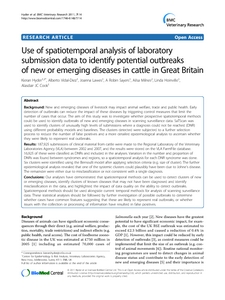Hyder, K; Vidal-Diez, A; Lawes, J; Sayers, AR; Milnes, A; Hoinville, L; Cook, AJ
(2011)
Use of spatiotemporal analysis of laboratory submission data to identify potential outbreaks of new or emerging diseases in cattle in Great Britain.
BMC Veterinary Research, 7 (14).
ISSN 1746-6148
https://doi.org/10.1186/1746-6148-7-14
SGUL Authors: Vidal-Diez, Alberto
![[img]](https://openaccess.sgul.ac.uk/100046/1.hassmallThumbnailVersion/1746-6148-7-14.pdf)  Preview |
|
["document_typename_application/pdf; charset=binary" not defined]
Published Version
Download (650kB)
| Preview
|
Abstract
BACKGROUND: New and emerging diseases of livestock may impact animal welfare, trade and public health. Early detection of outbreaks can reduce the impact of these diseases by triggering control measures that limit the number of cases that occur. The aim of this study was to investigate whether prospective spatiotemporal methods could be used to identify outbreaks of new and emerging diseases in scanning surveillance data. SaTScan was used to identify clusters of unusually high levels of submissions where a diagnosis could not be reached (DNR) using different probability models and baselines. The clusters detected were subjected to a further selection process to reduce the number of false positives and a more detailed epidemiological analysis to ascertain whether they were likely to represent real outbreaks.
RESULTS: 187,925 submissions of clinical material from cattle were made to the Regional Laboratory of the Veterinary Laboratories Agency (VLA) between 2002 and 2007, and the results were stored on the VLA FarmFile database. 16,925 of these were classified as DNRs and included in the analyses. Variation in the number and proportion of DNRs was found between syndromes and regions, so a spatiotemporal analysis for each DNR syndrome was done. Six clusters were identified using the Bernoulli model after applying selection criteria (e.g. size of cluster). The further epidemiological analysis revealed that one of the systemic clusters could plausibly have been due to Johne's disease. The remainder were either due to misclassification or not consistent with a single diagnosis.
CONCLUSIONS: Our analyses have demonstrated that spatiotemporal methods can be used to detect clusters of new or emerging diseases, identify clusters of known diseases that may not have been diagnosed and identify misclassification in the data, and highlighted the impact of data quality on the ability to detect outbreaks. Spatiotemporal methods should be used alongside current temporal methods for analysis of scanning surveillance data. These statistical analyses should be followed by further investigation of possible outbreaks to determine whether cases have common features suggesting that these are likely to represent real outbreaks, or whether issues with the collection or processing of information have resulted in false positives.
| Item Type: |
Article
|
| Additional Information: |
PMCID: PMC3070640
© 2011 Hyder et al; licensee BioMed Central Ltd. This is an Open Access article distributed under the terms of the Creative Commons Attribution License (http://creativecommons.org/licenses/by/2.0), which permits unrestricted use, distribution, and reproduction in any medium, provided the original work is properly cited. |
| Keywords: |
Animals, Cattle, Cattle Diseases, Communicable Diseases, Emerging, Databases, Factual, Disease Outbreaks, Great Britain, Paratuberculosis, Population Surveillance, Prospective Studies, Reproducibility of Results, Space-Time Clustering |
| SGUL Research Institute / Research Centre: |
Academic Structure > Population Health Research Institute (INPH) |
| Journal or Publication Title: |
BMC Veterinary Research |
| ISSN: |
1746-6148 |
| PubMed ID: |
21418593 |
| Web of Science ID: |
21418593 |
| Dates: |
| Date |
Event |
| 2011-03-19 |
Published |
|
  |
Download EPMC Full text (PDF)
|
 |
Download EPMC Full text (HTML)
|
 |
Go to PubMed abstract |
| URI: |
https://openaccess.sgul.ac.uk/id/eprint/100046 |
| Publisher's version: |
https://doi.org/10.1186/1746-6148-7-14 |
Statistics
Item downloaded times since 23 Aug 2012.
Actions (login required)
 |
Edit Item |




